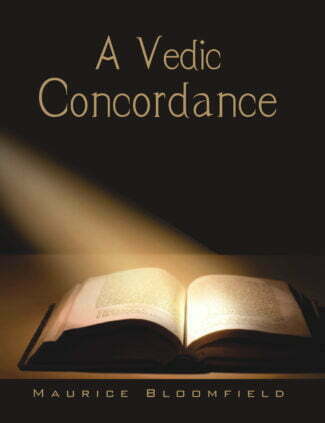Showing 121–124 of 124 results

This volume, originally published in 1906 as part of the Harvard Oriental Series, is an alphabetic index to every line of every stanza of the published Vedic literature and to the liturgical formulas; it is an index to the Vedic mantras, together with an account of their variations in the different Vedic books.
This volume, A Vedic Concordance, is part of the Harvard Oriental Series. This reprint of the 1906 edition is an alphabetic index to every line of every stanza of the published Vedic literature and to the liturgical formulas; it is an index to the Vedic mantras, together with an account of their variations in the different Vedic books.
This volume is expected to serve two purposes. 1. It gives a comprehensive index of all the mantras. 2. It registers the variants of mantras that are not wholly identical. In addition, it spells out few secondary uses. (i) It is a key to the liturgical employment of the mantras. (ii) It is virtually a finding-index of rites and practices. (iii) It is a tool for future editors of Vedic texts. (iv) It is a repertory of the most archaic Hindu prose. (v) It also provides some miscellaneous uses to the future researchers in the domain of Vedic studies and sciences.
A must buy for all universities, colleges, institutions, scholars, researchers, and students who are engaged in Vedic studies.

This volume contains scholarly papers from the Veda Sessions of the 15th World Sanskrit Conference, touching a broad spectrum of the Vedic tradition and focusing on three major aspects of that tradition: language and linguistics; textual criticism and text edition; and culture, philosophy, mythology.
The Vedas hold a position of prominence, both as the oldest documents of Sanskrit and as the most venerable texts of Hinduism.
This volume contains scholarly papers from the Veda Sessions of the 15th World Sanskrit Conference, touching a broad spectrum of the Vedic tradition and focusing on three major aspects of that tradition: language and linguistics; textual criticism and text edition; and culture, philosophy, mythology.
Language and linguistics papers range from syntax and semantics (Hock, Küummel) to morphology (Tucker), onomastics (Pinault) and rhetorical structure (Klein). Remarkably, three of the articles in the second part deal with the tradition of Atharvaveda (Bahulkar, Kulkarni, and Rotaru and Sumant); the remaining two focus on Rigveda (Khare and Köhler). Two papers in the last part deal with matters of Vedic philosophy (Benedetti and Vedi), one is devoted to mythology and ritual (Gadgil), and one addresses ritual and material culture (Nishimura).

Of a rare kind, this book does comparative analyses after studying seventeen Grhya-Sutras across four Vedas of the number and type of rituals of marriage in each Grhya-Sutra and the order of performance of rituals. It also lists the mantras (with English translation) and their sources and talks about the differences in employing the mantras.
Vivaha (marriage), in Hindu society, is one of the most important samskaras, out of the sixteen sacraments, which a person steps in with full understanding/consciousness. Marriage is a fascinating experience that stays alive in ones mind throughout the life. The mantras and slokas of the Grhya-Sutras of the four Vedas, chanted in this ritual, are in Sanskrit and a vast majority is unaware of their meanings and just follows the instructions of the celebrant priest, purohita.
The author delves deep into the Grhya-Sutras of Vedas and brings forth the details of vivaha samskara principles, philosophy, practices, rituals and so on. Grhya-Sutras Asvalayana, Sankhayana and Kausitaki of Rigveda; Paraskara (Sukhla Yajurveda), Apastamba and Hiranyakesin (Krsna Yajurveda), Baudhayana, Varaha, Manava, Agnivesya, Bharadvaja, Kathaka and Vaikhanasa of Yajurveda; Gobhila, Khadira and Jaimini of Samaveda; and Kausika of Atharvaveda are well explored and seriously analysed, having given the original mantras in Sanskrit with their English translation.
Of a rare kind, this book does comparative analyses of the number and type of rituals in each Grhya-Sutra and the order of performance of rituals.
This scholarly work creates a sudden seriousness and sanctity to vivaha samskara through the detailing of mantras and the rituals. Being in it, one is not far off the Vedic period, giving a new meaning and dimension to our understanding of Hindu vivaha samskara and its sanctity.

Vyangyavyakhya (interpretation of implied sense), ninth century, is the first performance text in Sanskrit applying dhvani to Bharata’s theatre. The author Kulasekhara deserves a place next to Anandavardhana and Abhinavagupta in the history of Natyasastra studies. The text is published for the first time.
The doctrine of dhvani, expounded by Anandavardhana (ninth century ce) in Kashmir though contested by his contemporaries at home, received sound acclamation in Kerala. A royal dramatist Kulashekhara of the same century applied dhvani to the theatre. His performance text is known as Vyangyavyakhya (VV), meaning interpreting the implied. This was an epoch-making event in the history of Indian theatre. This innovation in performative practices marked a deviation from Bharatas national tradition and laid down the foundation for classical forms like Kutiyattam, Kgrshnanattam, Kathakali and Mohiniyattam. VV today continues to inspire contemporary directors to formulate new interpretative sub-texts for ancient plays. VV, which remained in manuscripts till now, is published for the first time.
As icing on the cake, four eminent scholars K.D. Tripathy, Radhavallabh Tripathi, N.P. Unni and Kavalam Narayana Panikkar delve deep into the aspects of VV as introduction to this book. This volume discusses in detail the Sanskrit theatre until tenth century ce, performance texts of Dhananjayadhvani and Samvaranadhvani, and the developments in the post-Kulashekhara era.
VV should serve as a guide to all practitioners of performing arts, and should entice students, teachers and lovers of Indian performing arts.
| × |
|
Reconceptualizing the Sciences and the Humanities 1 x ₹1,080.00 |